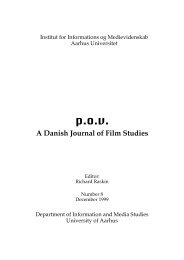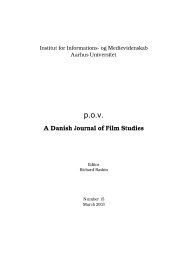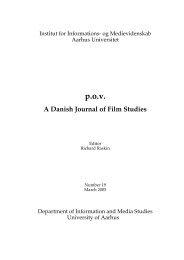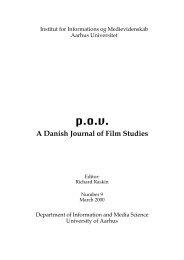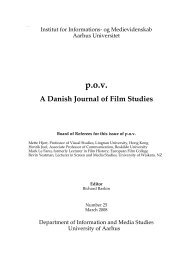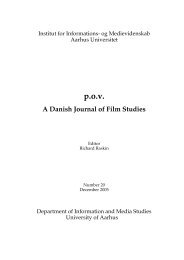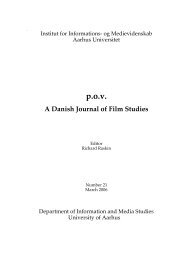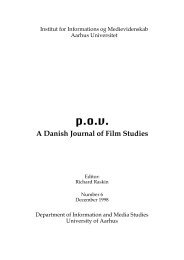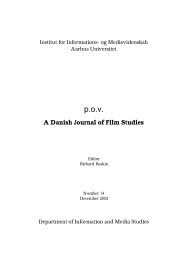The Face of Time - POV - Aarhus Universitet
The Face of Time - POV - Aarhus Universitet
The Face of Time - POV - Aarhus Universitet
Create successful ePaper yourself
Turn your PDF publications into a flip-book with our unique Google optimized e-Paper software.
82 p.o.v. number 13 March 2002<br />
visually and rhetorically organized in such a way that we clearly get<br />
the feeling <strong>of</strong> being completely controlled and suppressed. This is<br />
very strongly emphasized at the end <strong>of</strong> the film with sequences shot<br />
from the surveillance camera control room, the point <strong>of</strong> view <strong>of</strong> the<br />
anonymous ‘big brother.’<br />
<strong>The</strong> visual, documentary strategy established in Kieslowski’s<br />
first student film is thus amazingly mature and finished and was<br />
basically used throughout a large part <strong>of</strong> his other documentary<br />
films between 1960-1980. However, there are other tendencies where<br />
the observational style is used to show people trying to cope with a<br />
completely hopeless system, people doing a job and trying to avoid<br />
being identified with the system. One example is <strong>The</strong> Mason<br />
(Murarz, 1973), told in the first person by one <strong>of</strong> the early<br />
communist pioneers from the Stalin era before 1956. He looks back<br />
on his bureaucratic party future with dismay and he goes back to<br />
his job as a mason. His story is ironically told as he attends a May 1<br />
parade with all its bombastic rhetoric and symbolism celebrating the<br />
working class heroes while in fact promoting conformity and a<br />
ruling party class. An even better example is Hospital (Szpital, 1976),<br />
a very realistic portrait <strong>of</strong> life at a hospital where conditions are<br />
hopeless and can only be survived by black humor and commitment<br />
beyond belief. Here no symbolism is needed – the pictures <strong>of</strong> reality<br />
loudly speak for themselves.<br />
All in all, Kieslowski's contribution to the modern documentary<br />
film tradition is as important and solid as his feature film<br />
production. <strong>The</strong>re is a clear line from these narratives <strong>of</strong> reality to<br />
his <strong>of</strong>ten very realistic fiction, and there is a just as strong thematic<br />
continuity. Furthermore, the documentary voice is both very critical<br />
and social in its refined ways <strong>of</strong> getting the message through and at



